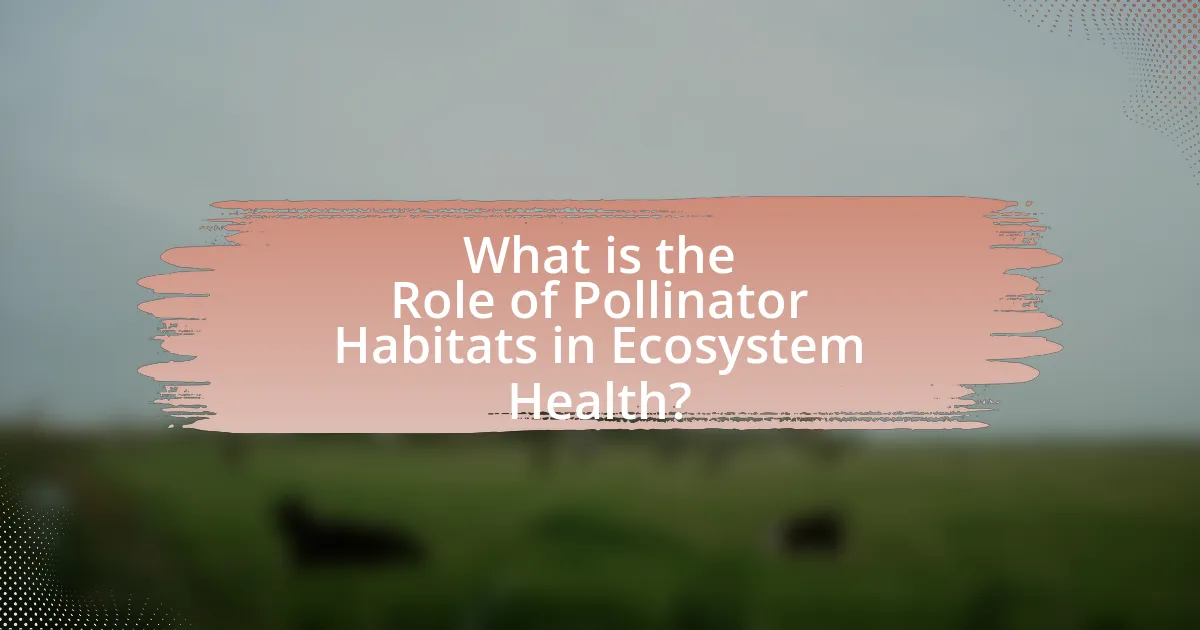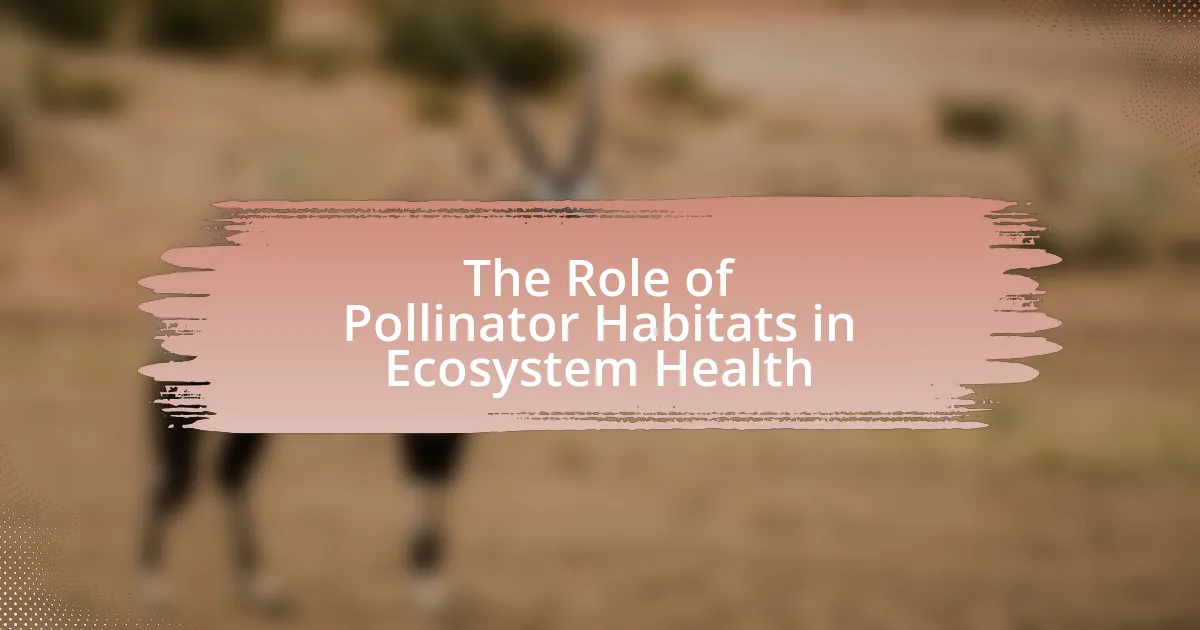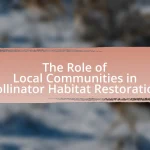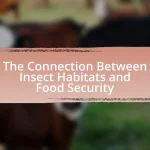Pollinator habitats are vital for ecosystem health, supporting the survival and activity of pollinators essential for the reproduction of flowering plants. Approximately 75% of global food crops rely on animal pollination, underscoring the connection between these habitats and food security. The article explores the types of pollinators that benefit from these habitats, their role in enhancing biodiversity and plant reproduction, and the threats they face, including habitat loss and pesticide use. Additionally, it discusses practical steps individuals and farmers can take to protect and enhance pollinator habitats, highlighting their broader implications for ecosystem services and economic value.

What is the Role of Pollinator Habitats in Ecosystem Health?
Pollinator habitats play a crucial role in ecosystem health by supporting the survival and activity of pollinators, which are essential for the reproduction of many flowering plants. These habitats provide food sources, nesting sites, and shelter for pollinators, thereby enhancing biodiversity and promoting plant reproduction. Research indicates that approximately 75% of global food crops depend on animal pollination, highlighting the direct link between pollinator habitats and food security. Furthermore, healthy pollinator populations contribute to ecosystem resilience, enabling ecosystems to better withstand environmental changes and disturbances.
Why are pollinator habitats essential for ecosystems?
Pollinator habitats are essential for ecosystems because they support the survival and reproduction of pollinators, which are crucial for the fertilization of many plants. Approximately 75% of flowering plants and 35% of global food crops depend on animal pollination, highlighting the integral role of pollinators in maintaining biodiversity and food security. Furthermore, healthy pollinator populations contribute to ecosystem resilience by promoting genetic diversity among plant species, which in turn supports various wildlife and stabilizes ecosystems.
What types of pollinators benefit from these habitats?
Bees, butterflies, and hummingbirds are the primary types of pollinators that benefit from these habitats. These pollinators rely on diverse flowering plants found in healthy ecosystems for food and reproduction. Research indicates that habitats rich in native flora support higher populations of these pollinators, enhancing their foraging efficiency and overall health. For instance, studies show that bee diversity increases significantly in areas with abundant wildflowers, which provide essential nectar and pollen resources.
How do pollinator habitats contribute to biodiversity?
Pollinator habitats significantly contribute to biodiversity by providing essential resources such as food and nesting sites for various species. These habitats support a wide range of plant species, which in turn attract diverse pollinators like bees, butterflies, and birds. Research indicates that areas with rich pollinator habitats can increase plant diversity by up to 50%, as these pollinators facilitate cross-pollination, leading to greater genetic variation and resilience among plant populations. This enhanced plant diversity supports a broader array of herbivores and predators, creating a more complex and stable ecosystem.
How do pollinator habitats influence plant reproduction?
Pollinator habitats significantly enhance plant reproduction by providing essential resources such as food and nesting sites for pollinators. These habitats support diverse pollinator populations, which are crucial for the transfer of pollen between flowering plants. Studies indicate that areas with rich pollinator habitats can increase fruit and seed set in plants by up to 50%, demonstrating a direct correlation between habitat quality and reproductive success. Furthermore, the presence of various pollinators, including bees and butterflies, leads to improved genetic diversity in plant populations, which is vital for resilience and adaptation.
What is the relationship between pollinators and flowering plants?
Pollinators and flowering plants have a mutualistic relationship, where pollinators facilitate the reproduction of flowering plants by transferring pollen from one flower to another. This process is essential for the fertilization of many plants, leading to the production of seeds and fruits. Approximately 75% of the world’s flowering plants depend on animal pollinators, including bees, butterflies, and birds, for successful reproduction. This interdependence not only supports plant diversity but also contributes to ecosystem health by maintaining food webs and providing habitats for various species.
How does pollination affect food production?
Pollination significantly enhances food production by facilitating the reproduction of flowering plants, which are essential for producing fruits, vegetables, and nuts. Approximately 75% of the world’s food crops depend on animal pollination, according to the Food and Agriculture Organization (FAO). This process not only increases crop yields but also improves the quality of the produce, leading to better nutritional value and economic benefits for farmers. In regions with high pollinator diversity, such as bees and butterflies, agricultural productivity can increase by up to 50%, demonstrating the critical role of pollination in sustaining food systems.
What are the threats to pollinator habitats?
The threats to pollinator habitats include habitat loss, pesticide use, climate change, and invasive species. Habitat loss, primarily due to urbanization and agricultural expansion, reduces the availability of food and nesting sites for pollinators. Pesticide use, particularly neonicotinoids, has been shown to harm pollinator populations by affecting their foraging behavior and reproductive success. Climate change alters the distribution of plants and pollinators, disrupting their interactions and timing. Invasive species can outcompete native plants that provide essential resources for pollinators, further diminishing their habitats. These factors collectively contribute to the decline of pollinator populations, which are crucial for ecosystem health and food production.
How does habitat loss impact pollinator populations?
Habitat loss significantly reduces pollinator populations by diminishing their food sources and nesting sites. When natural habitats are destroyed or fragmented, the availability of flowering plants, which provide nectar and pollen, decreases, leading to nutritional stress for pollinators. Research indicates that areas with high habitat diversity support greater pollinator abundance and diversity; for instance, a study published in “Ecological Applications” found that habitat loss can lead to a 50% decline in pollinator species richness. Additionally, habitat fragmentation isolates populations, making it difficult for pollinators to find mates and reducing genetic diversity, which is crucial for their resilience.
What role do pesticides play in the decline of pollinator habitats?
Pesticides significantly contribute to the decline of pollinator habitats by reducing the availability of food sources and directly harming pollinator populations. Studies have shown that neonicotinoids, a class of pesticides, can impair the foraging behavior and reproductive success of bees, leading to population declines. For instance, research published in the journal “Nature” by Goulson et al. (2015) indicates that exposure to these chemicals can result in decreased survival rates and disrupted navigation in honeybees. Additionally, pesticide application can lead to habitat degradation, as it often targets flowering plants that provide essential resources for pollinators, further diminishing their habitats.
How can we protect and enhance pollinator habitats?
To protect and enhance pollinator habitats, implement practices such as planting native flowering plants, reducing pesticide use, and creating diverse landscapes. Native flowering plants provide essential food sources for pollinators, while minimizing pesticide application helps to reduce harmful exposure. Diverse landscapes, including wildflower meadows and hedgerows, support a variety of pollinator species by offering shelter and nesting sites. Research indicates that areas with higher plant diversity can support up to 50% more pollinator species, demonstrating the importance of these practices in maintaining healthy ecosystems.
What practices can farmers adopt to support pollinators?
Farmers can adopt practices such as planting diverse flowering crops, creating hedgerows, and reducing pesticide use to support pollinators. Planting a variety of flowering plants provides a continuous food source for pollinators throughout the growing season, which is essential for their survival. Establishing hedgerows offers shelter and nesting sites, enhancing habitat availability. Additionally, minimizing pesticide application, especially during flowering periods, reduces harmful exposure to pollinators, thereby promoting their health and populations. Research indicates that farms with diverse plantings and reduced pesticide use have higher pollinator abundance and diversity, which is crucial for ecosystem health.
How can urban areas create pollinator-friendly environments?
Urban areas can create pollinator-friendly environments by incorporating native plants, establishing green spaces, and reducing pesticide use. Native plants provide essential food sources and habitats for pollinators, as they are adapted to local ecosystems and attract a variety of species. For instance, studies show that urban gardens with native flora can increase pollinator diversity by up to 50%. Additionally, creating green roofs, community gardens, and pollinator parks enhances habitat availability, while minimizing pesticide application protects pollinator health. These strategies collectively contribute to healthier ecosystems and support biodiversity in urban settings.
What are the broader implications of healthy pollinator habitats?
Healthy pollinator habitats significantly enhance biodiversity and ecosystem stability. These habitats support a variety of pollinators, such as bees and butterflies, which are crucial for the reproduction of many flowering plants. Research indicates that approximately 75% of global food crops depend on animal pollination, underscoring the economic importance of maintaining these habitats. Furthermore, healthy pollinator populations contribute to soil health and water retention, which are vital for agricultural productivity and resilience against climate change. Studies have shown that diverse plant communities fostered by pollinators can improve ecosystem services, such as pest control and nutrient cycling, thereby promoting overall environmental health.
How do pollinator habitats affect ecosystem services?
Pollinator habitats significantly enhance ecosystem services by promoting biodiversity and improving plant reproduction. These habitats provide essential resources such as food and nesting sites for pollinators, which in turn facilitate the pollination of flowering plants. Research indicates that effective pollination can increase crop yields by up to 40%, demonstrating the direct economic value of pollinator services. Additionally, diverse pollinator populations contribute to the stability and resilience of ecosystems, ensuring the continued provision of services like water purification and soil fertility. Thus, the presence of healthy pollinator habitats is crucial for maintaining and enhancing ecosystem services.
What is the economic value of maintaining pollinator habitats?
The economic value of maintaining pollinator habitats is estimated to be between $235 billion and $577 billion annually, as these habitats support the pollination of crops and wild plants essential for food production and biodiversity. Pollinators, such as bees and butterflies, contribute to the pollination of over 75% of the world’s flowering plants, including 35% of global food crops, which underscores their critical role in agricultural productivity. Studies indicate that the decline of pollinator populations could lead to significant economic losses, with potential impacts on food security and agricultural economies worldwide.
What practical steps can individuals take to support pollinator habitats?
Individuals can support pollinator habitats by planting native flowering plants, which provide essential food sources for pollinators. Research indicates that native plants are more beneficial for local pollinator species, as they have co-evolved with these species and offer the right nutrients and pollen. Additionally, individuals can reduce pesticide use, as chemicals can harm pollinator populations; studies show that neonicotinoids, a common class of pesticides, have been linked to declines in bee populations. Creating bee hotels or nesting sites can also enhance habitat availability, as many pollinators require specific nesting conditions. Lastly, maintaining a diverse garden with various flowering plants throughout the growing season ensures a continuous food supply, which is crucial for sustaining pollinator populations.


